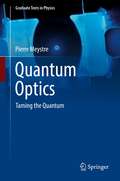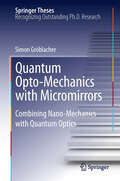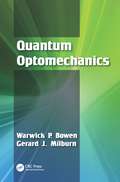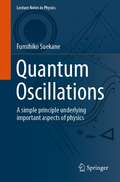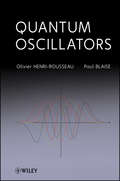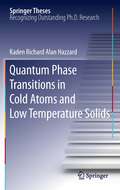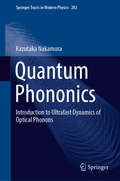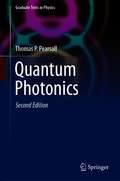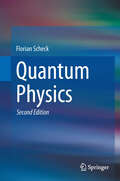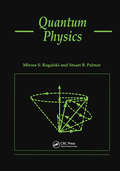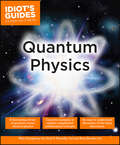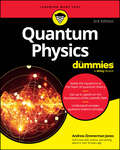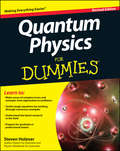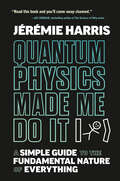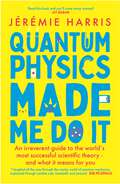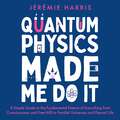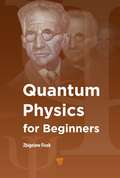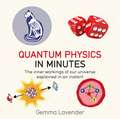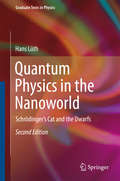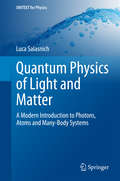- Table View
- List View
Quantum Optics: Taming the Quantum (Graduate Texts in Physics)
by Pierre MeystreThis book is a thoroughly modern and highly pedagogical graduate-level introduction to quantum optics, a subject which has witnessed stunning developments in recent years and has come to occupy a central role in the 'second quantum revolution'. The reader is invited to explore the fundamental role that quantum optics plays in the control and manipulation of quantum systems, leading to ultracold atoms, circuit QED, quantum information science, quantum optomechanics, and quantum metrology. The building blocks of the subject are presented in a sequential fashion, starting from the simplest physical situations before moving to increasingly complicated ones. This pedagogically appealing approach leads to quantum entanglement and measurement theory being introduced early on and before more specialized topics such as cavity QED or laser cooling. The final chapter illustrates the power of scientific cross-fertilization by surveying cutting-edge applications of quantum optics and optomechanics in gravitational wave detection, tests of fundamental physics, searches for dark matter, geophysical monitoring, and ultraprecise clocks. Complete with worked examples and exercises, this book provides the reader with enough background knowledge and understanding to follow the current journal literature and begin producing their own original research.
Quantum Opto-Mechanics with Micromirrors
by Simon GröblacherQuantum effects in macroscopic systems have long been a fascination for researchers. Over the past decade mechanical oscillators have emerged as a leading system of choice for many such experiments. The work reported in this thesis investigates the effects of the radiation-pressure force of light on macroscopic mechanical structures. The basic system studied is a mechanical oscillator that is highly reflective and part of an optical resonator. It interacts with the optical cavity mode via the radiation-pressure force. Both the dynamics of the mechanical oscillation and the properties of the light field are modified through this interaction. The experiments use quantum optical tools (such as homodyning and down-conversion) with the goal of ultimately showing quantum behavior of the mechanical center of mass motion. Of particular value are the detailed descriptions of several novel experiments that pave the way towards this goal and are already shaping the field of quantum optomechanics, in particular optomechanical laser cooling and strong optomechanical coupling.
Quantum Optomechanics
by Gerard J. Milburn Warwick P. BowenWritten by leading experimentalist Warwick P. Bowen and prominent theoretician Gerard J. Milburn, Quantum Optomechanics discusses modern developments in this novel field from experimental and theoretical standpoints. The authors share their insight on a range of important topics, including optomechanical cooling and entanglement; quantum limits on
Quantum Oscillations and Charge-Neutral Fermions in Topological Kondo Insulator YbB₁₂ (Springer Theses)
by Yuki SatoElectronic state of every solid is basically classified into two categories according to its electrical responses: insulator or metal. A textbook of modern solid state physics explains that shape of a Fermi surface plays a key role in most physical properties in metals. One of the well-established experimental methods to detect a Fermi surface is measurement of quantum oscillations that is a periodic response of physical quantities with respect to external magnetic fields. As insulators do not host Fermi surface, it is believed that they do not exhibit any quantum oscillations.This book presents a comprehensive review of recent observations of quantum oscillations in the Kondo insulators, SmB6 and YbB12, and discusses how the observations are demonstrated by a newly proposed mechanism where emergent charge-neutral fermions exhibit quantum oscillations instead of bare electrons. It also focuses on topological properties of Kondo insulators, and demonstrates that YbB12 hosts a surface metallic conduction owing to its non-trivial band structure. Further it presents the experiments of specific heat and thermal conductivity in YbB12 down to ultra-low temperature to discuss the possible low-energy excitations from a Fermi surface of neutral fermions. The demonstrated gapless and itinerant fermionic excitations, that is the significant contribution from charge neutral fermions, violates Wiedemann-Franz law. The discoveries point out a highly unconventional phase of quantum state—electrically insulating but thermally metallic—realized in the bulk of topological Kondo insulators.
Quantum Oscillations: A simple principle underlying important aspects of physics (Lecture Notes in Physics #985)
by Fumihiko SuekaneThis book addresses various aspects of physics, using Quantum oscillation (QO) as a common denominator. QO plays an important role in many aspects of physics, such as the Weinberg angle, Caribbo angle, neutrino oscillation, K0 oscillation and CP violation, mass generation by the Higgs field, hadron mass pattern, lepton anomalous magnetic moment, spin precession, hydrogen HI line, etc.Usually, these subjects are taught separately. As such, this book allows readers to learn about a wide range of physics subjects in a unified manner and to gain farther-reaching perspectives. The readers may be surprised at the fact that different looking physics are actually closely related with each other. They will also find essential information on quantum mechanics at the heart from many concrete examples. Though the book is mainly intended for graduate students of particle, nuclear and astrophysics, undergraduate students and researchers will also benefit from the content.
Quantum Oscillators
by Olivier Henri-Rousseau Paul BlaiseAn invaluable reference for an overall but simple approach to the complexity of quantum mechanics viewed through quantum oscillators Quantum oscillators play a fundamental role in many areas of physics; for instance, in chemical physics with molecular normal modes, in solid state physics with phonons, and in quantum theory of light with photons. Quantum Oscillators is a timely and visionary book which presents these intricate topics, broadly covering the properties of quantum oscillators which are usually dispersed in the literature at varying levels of detail and often combined with other physical topics. These properties are: time-independent behavior, reversible dynamics, thermal statistical equilibrium and irreversible evolution toward equilibrium, together with anharmonicity and anharmonic couplings. As an application of these intricate topics, special attention is devoted to infrared lineshapes of single and complex (undergoing Fermi resonance or Davydov coupling) damped H-bonded systems, providing key insights into this rapidly evolving area of chemical science. Quantum Oscillators is a long overdue update in the literature surrounding quantum oscillators, and serves as an excellent supplementary text in courses on IR spectroscopy and hydrogen bonding. It is a must-have addition to the library of any graduate or undergraduate student in chemical physics.
Quantum Phase Transitions
by Subir SachdevDescribing the physical properties of quantum materials near critical points with long-range many-body quantum entanglement, this book introduces readers to the basic theory of quantum phases, their phase transitions and their observable properties. This second edition begins with a new section suitable for an introductory course on quantum phase transitions, assuming no prior knowledge of quantum field theory. It also contains several new chapters to cover important recent advances, such as the Fermi gas near unitarity, Dirac fermions, Fermi liquids and their phase transitions, quantum magnetism, and solvable models obtained from string theory. After introducing the basic theory, it moves on to a detailed description of the canonical quantum-critical phase diagram at non-zero temperatures. Finally, a variety of more complex models are explored. This book is ideal for graduate students and researchers in condensed matter physics and particle and string theory.
Quantum Phase Transitions in Cold Atoms and Low Temperature Solids
by Kaden Richard HazzardThe primary focus of this thesis is to theoretically describe nanokelvin experiments in cold atomic gases, which offer the potential to revolutionize our understanding of strongly correlated many-body systems. The thesis attacks major challenges of the field: it proposes and analyzes experimental protocols to create new and interesting states of matter and introduces theoretical techniques to describe probes of these states. The phenomena considered include the fractional quantum Hall effect, spectroscopy of strongly correlated states, and quantum criticality, among others. The thesis also clarifies experiments on disordered quantum solids, which display a variety of exotic phenomena and are candidates to exhibit so-called "supersolidity." It collects experimental results and constrains their interpretation through theoretical considerations. This Doctoral Thesis has been accepted by Cornell University, Ithaca, USA.
Quantum Philosophy: Understanding and Interpreting Contemporary Science
by Roland OmnèsIn this magisterial work, Roland Omnès takes us from the academies of ancient Greece to the laboratories of modern science as he seeks to do no less than rebuild the foundations of the philosophy of knowledge. One of the world's leading quantum physicists, Omnès reviews the history and recent development of mathematics, logic, and the physical sciences to show that current work in quantum theory offers new answers to questions that have puzzled philosophers for centuries: Is the world ultimately intelligible? Are all events caused? Do objects have definitive locations? Omnès addresses these profound questions with vigorous arguments and clear, colorful writing, aiming not just to advance scholarship but to enlighten readers with no background in science or philosophy. The book opens with an insightful and sweeping account of the main developments in science and the philosophy of knowledge from the pre-Socratic era to the nineteenth century. Omnès then traces the emergence in modern thought of a fracture between our intuitive, commonsense views of the world and the abstract and--for most people--incomprehensible world portrayed by advanced physics, math, and logic. He argues that the fracture appeared because the insights of Einstein and Bohr, the logical advances of Frege, Russell, and Gödel, and the necessary mathematics of infinity of Cantor and Hilbert cannot be fully expressed by words or images only. Quantum mechanics played an important role in this development, as it seemed to undermine intuitive notions of intelligibility, locality, and causality. However, Omnès argues that common sense and quantum mechanics are not as incompatible as many have thought. In fact, he makes the provocative argument that the "consistent-histories" approach to quantum mechanics, developed over the past fifteen years, places common sense (slightly reappraised and circumscribed) on a firm scientific and philosophical footing for the first time. In doing so, it provides what philosophers have sought through the ages: a sure foundation for human knowledge. Quantum Philosophy is a profound work of contemporary science and philosophy and an eloquent history of the long struggle to understand the nature of the world and of knowledge itself.
Quantum Phononics: Introduction to Ultrafast Dynamics of Optical Phonons (Springer Tracts in Modern Physics #282)
by Kazutaka NakamuraThis book presents quantum phononics as an exciting new field of research, and introduces readers to the quantum nature of phonons and their application to quantum technologies. Both the theory of and recent experiments in “quantum phononics,” involving e.g. coherent phonons, phonon squeezing, coherent control, and phonon quantum technologies, are presented. The theoretical background of the generation and detection of phonons is described in a way that will be easy to understand for graduate students and experimental scientists who are newcomers to the field. Moreover, the book focuses on coherent phonons produced by ultrafast laser pulses, which can be used for the coherent control of atomic motions in solids and phase transformation. The laser-matter interaction is treated using a density matrix formalism of the time-dependent Schröedinger equation. In addition, the third-order nonlinear optical response of condensed matter is also described.
Quantum Photonics (Graduate Texts in Physics)
by Thomas P. PearsallPhotonics is the discipline of electrons and photons working in tandem to create new physics, new devices and new applications. This textbook employs a pedagogical approach that facilitates access to the fundamentals of quantum photonics. Beginning with a review of the quantum properties of photons and electrons, the book then introduces the concept of their non-locality at the quantum level. It presents a determination of electronic band structure using the pseudopotential method, enabling the student to directly compute the band structures of most group IV, group III-V, and group II-VI semiconductors. The book devotes further in-depth discussion of second quantization of the electromagnetic field that describes spontaneous and stimulated emission of photons, quantum entanglement and introduces the topic of quantum cascade lasers, showing how electrons and photons interact in a quantum environment to create a practical photonic device.This extended second edition includes a detailed description of the link between quantum photon states and the macroscopic electric field. It describes the particle qualities of quantum electrons via their unique operator algebra and distinguishable behavior from photons, and employs these fundamentals to describe the quantum point contact, which is the quantum analogue of a transistor and the basic building block of all nanoscopic circuits, such as electron interferometers.Pearsall’s Quantum Photonics is supported by numerous numerical calculations that can be repeated by the reader, and every chapter features a reference list of state-of-the art research and a set of exercises. This textbook is an essential part of any graduate-level course dealing with the theory of nanophotonic devices or computational physics of solid-state quantum devices based on nanoscopic structures.
Quantum Physics
by Alastair I. M. RaeOf all modern scientific theories, quantum theory has perhaps done more than any other to change the way we think about basic structure of the universe. This clear and accessible introduction covers quantum physics in theory and in practice, and explains why it has become known not just as a theory, but as a revolution.
Quantum Physics
by Florian ScheckScheck's Quantum Physics presents a comprehensive introductory treatment, ideally suited for a two-semester course. Part One covers the basic principles and prime applications of quantum mechanics, from the uncertainty relations to many-body systems. Part Two introduces to relativistic quantum field theory and ranges from symmetries in quantum physics to electroweak interactions. Numerous worked-out examples as well as exercises, with solutions or hints, enables the book's use as an accompanying text for courses, and also for independent study. For both parts, the necessary mathematical framework is treated in adequate form and detail. The book ends with appendices covering mathematical fundamentals and enrichment topics, plus selected biographical notes on pioneers of quantum mechanics and quantum field theory. The new edition was thoroughly revised and now includes new sections on quantization using the path integral method and on deriving generalized path integrals for bosonic and fermionic fields.
Quantum Physics
by Mircea S. Rogalski Stuart B. PalmerThis book presents the basic concepts and methods of quantum mechanics for upper level undergraduate students, allowing them to master its application to real physical situations. A postulate-based treatment is adopted together with a gradual development of the quantum formalism of wave functions, operators, measurement and temporal evolution. Standard topics of one-dimensional and atomic motion, angular momentum and approximation methods are presented in addition to detailed discussions of many-particle systems, atomic and nuclear radiation. Appropriate mathematical tools and techniques are provided wherever necessary. The core text is supplemented by 77 worked examples, some of which address more complex issues and aspects of present-day research. The aim is to make this textbook a realistic introduction to more advanced and specialized texts. The material provides full coverage of the subject matter, 94 problems with solutions and a further 93 with answers only
Quantum Physics (Idiot's Guides)
by Paul V. Pancella Marc HumphreyQuantum physics explores the behavior of matter and energy at the molecular, atomic, nuclear, and even smaller levels. Idiot's Guides: Quantum Physics explores this very complex topic, while making it easy-to-understand for science enthusiasts and students alike. It skips the complicated math and dives right in to all of the concepts, paradoxes, and implications that make quantum physics so fascinating. Topics include quantum vs. classical physics, the famous double-slit experiment, quantum wave function, the Heisenberg Uncertainty Principle, the Schrodinger's cat thought experiment, quantum entanglement, competing interpretations, quantum gravity, and much more.
Quantum Physics For Dummies
by Andrew Zimmerman JonesThe plain-English guide to understanding quantum physics Mastering quantum physics is no easy feat, but with the help of Quantum Physics For Dummies you can work at your own pace to unlock key concepts and fascinating facts. Packed with invaluable explanations, equations, and step-by-step instructions, this book makes a challenging subject much more accessible. Great for college students taking a quantum physics course, Quantum Physics For Dummies offers complete coverage of the subject, along with numerous examples to help you tackle the tough stuff. The Schrodinger Equation, the foundations of quantum physics, vector notation, scattering theory, angular momentum—it’s all in here. This handy guide helps you prepare for exams and succeed at learning quantum physics. Get clear explanations of the core concepts in quantum physics Review the math principles needed for quantum physics equations Learn the latest breakthroughs and research in the field Clarify difficult subjects and equations from your college courseQuantum Physics For Dummies is great a resource for students who need a supplement to the textbook to help them tackle this challenging subject.
Quantum Physics For Dummies
by Steven HolznerQuantum Physics For Dummies, Revised Edition helps make quantum physics understandable and accessible. From what quantum physics can do for the world to understanding hydrogen atoms, readers will get complete coverage of the subject, along with numerous examples to help them tackle the tough equations. Compatible with classroom text books and courses, Quantum Physics For Dummies, Revised Edition lets students study at their own paces and helps them prepare for graduate or professional exams. Coverage includes: The Schrodinger Equation and its Applications The Foundations of Quantum Physics Vector Notation Spin Scattering Theory, Angular Momentum, and more Your plain-English guide to understanding and working with the micro world Quantum physics — also called quantum mechanics or quantum field theory — can be daunting for even the most dedicated student or enthusiast of science, math, or physics. This friendly, concise guide makes this challenging subject understandable and accessible, from atoms to particles to gases and beyond. Plus, it's packed with fully explained examples to help you tackle the tricky equations like a pro! Compatible with any classroom course — study at your own pace and prepare for graduate or professional exams Your journey begins here — understand what quantum physics is and what kinds of problems it can solve Know the basic math — from state vectors to quantum matrix manipulations, get the foundation you need to proceed Put quantum physics to work — make sense of Schrödinger's equation and handle particles bound in square wells and harmonic oscillators Solve problems in three dimensions — use the full operators to handle wave functions and eigenvectors to find the natural wave functions of a system Discover the latest research — learn the cutting-edge quantum physics theories that aim to explain the universe itself
Quantum Physics Made Me Do It: A Simple Guide to the Fundamental Nature of Everything
by Jeremie HarrisAn entertaining and accessible dive into the riveting world described by quantum mechanics, from physicist, AI risk expert, and Hollywood &“alternative reality&” consultant Jérémie Harris.Are human beings immortal? Are apples conscious? Do our legal systems make assumptions about free will that are just plain wrong? Of all the terrific books on quantum physics—from Stephen Hawking to Brian Greene—the questions they never seem to satisfy are the implications of the science. We know that quantum physics is real—our phones and computers wouldn&’t work if the science wasn&’t right. But what does it all mean?Does it mean that we live in one among a near-infinity of parallel universes? Or that everything that happens in the universe is pre-ordained—right down to what we think and how we act? Or does the science point in a stranger direction—towards the idea that the entire universe is one big mind? If one of these is true, what would it mean for our place in the universe, our immortal souls, and the future of humanity itself?The most basic encounter with quantum physics leads us to a dizzying array of incredible implications, each one more capable than the last of blowing our minds—all of which can be engaged without advanced math or deep knowledge of theory.Enter: Quantum Physics Made Me Do It—a smart, accessible, and engaging adventure through the complex and beautiful world mapped out by modern physics. Jérémie Harris at last offers us a book on quantum physics that the entire universe can enjoy—perhaps together as one big mind.
Quantum Physics Made Me Do It: A Simple Guide to the Fundamental Nature of Everything from Consciousness and Free Will to Parallel Universes and Eternal Life
by Jérémie HarrisFrom Silicon Valley entrepreneur, quantum physicist, AI risk expert, and Hollywood "alternative reality" consultant Jérémie Harris, comes an entertaining and accessible look at the world of quantum physics.The discovery of quantum mechanics has paved the way to just about every important innovation in the last half century: it has led us to the technology that powers microwaves, iPhones, and self-driving cars and is about to trigger a computing revolution that will either spell the end of the human species or propel us to heights we've never imagined. But there's another reason that quantum mechanics is so important: it is really the only way we can understand ourselves and each other. For the last hundred years or so, physicists have been feverishly debating what quantum theory has to say about you: what you're made of, whether you have free will, what will happen to you when you die, and much more. QUANTUM PHYSICS MADE ME DO IT is an amusing, irreverent exploration of the most successful scientific theory in human history, and a smart, entertaining adventure through the complex and beautiful world mapped out by modern physics.
Quantum Physics Made Me Do It: A Simple Guide to the Fundamental Nature of Everything from Consciousness and Free Will to Parallel Universes and Eternal Life
by Jérémie HarrisWhat the most successful scientific theory in history teaches us about being human.From Silicon Valley entrepreneur, quantum physicist, AI risk expert, and Hollywood "alternative reality" consultant Jérémie Harris, comes an entertaining and accessible look at the world of quantum physics.The discovery of quantum mechanics has paved the way to just about every important innovation in the last half century: it has led us to the technology that powers microwaves, iPhones, and self-driving cars and is about to trigger a computing revolution that will either spell the end of the human species or propel us to heights we've never imagined. But there's another reason that quantum mechanics is so important: it is really the only way we can understand ourselves and each other. For the last hundred years or so, physicists have been feverishly debating what quantum theory has to say about you: what you're made of, whether you have free will, what will happen to you when you die, and much more. QUANTUM PHYSICS MADE ME DO IT is an amusing, irreverent exploration of the most successful scientific theory in human history, and a smart, entertaining adventure through the complex and beautiful world mapped out by modern physics.(p) 2023 Penguin Random House Canada Limited
Quantum Physics and Geometry (Lecture Notes of the Unione Matematica Italiana #25)
by Valter Moretti Edoardo Ballico Alessandra Bernardi Iacopo Carusotto Sonia MazzucchiThis book collects independent contributions on current developments in quantum information theory, a very interdisciplinary field at the intersection of physics, computer science and mathematics. Making intense use of the most advanced concepts from each discipline, the authors give in each contribution pedagogical introductions to the main concepts underlying their present research and present a personal perspective on some of the most exciting open problems. Keeping this diverse audience in mind, special efforts have been made to ensure that the basic concepts underlying quantum information are covered in an understandable way for mathematical readers, who can find there new open challenges for their research. At the same time, the volume can also be of use to physicists wishing to learn advanced mathematical tools, especially of differential and algebraic geometric nature.
Quantum Physics for Beginners
by Zbigniew FicekThe textbook covers the background theory of various effects discussed from first principles, as clearly as possible, to introduce students to the main ideas of quantum physics and to teach the basic mathematical methods and techniques used in the fields of advanced quantum physics, atomic physics, laser physics, nanotechnology, quantum chemistry, and theoretical mathematics. Many of the predictions of quantum physics appear to be contrary to our intuitive perceptions, and the student will learn how it comes about that microscopic objects (particles) behave in unusual ways that are called quantum effects, what we mean by quantum, and where this idea came from. The textbook is supplemented with Problems and Solutions in Quantum Physics, which contains a wide range of tutorial problems from simple confidence builders to fairly challenging problems that provide adequate understanding of the basic concepts of quantum physics.
Quantum Physics in Minutes (In Minutes)
by Gemma LavenderQuantum physics is the most fundamental -- but also the most baffling -- branch of science. Allowing for dead-and-alive cats, teleportation, antimatter, and parallel universes, as well as underpinning all of our digital technology, it's as important as it is mind-bending. This clear and compact book demystifies the strange and beautiful quantum world, and hence the nature of reality itself.Contents include: Schrodinger's cat, inside the atom, the particle zoo, the Higgs boson, Heisenberg's uncertainty principle, God playing dice, relativity, the Big Bang, dark energy and matter, black holes, the fate of the Universe, the Theory of Everything, quantum gravity, string theory, the multiverse, instant communication, quantum computing and cryptography, superconductivity, quantum biology, quantum consciousness, and much more. Written as a series of mini essays with 200 simple diagrams to help understanding, there can be no easier guide to this notoriously confusing subject. At last it's possible for non-specialists to understand quantum theory and its central role in the birth of the universe and the very existence of life.
Quantum Physics in the Nanoworld
by Hans LüthThe book deals with all essential aspects of non-relativistic quantum physics up to the quantization of fields. In contrast to common textbooks of quantum mechanics, modern experiments are described both for the purpose of foundation of the theory and in relation to recent applications. In this respect applications to nano-electronics as well as the realization of quantum-bits are presented and discussed. Furthermore, links are made to other important research fields and applications, such as elementary particle physics, solid state physics and nuclear magnetic resonance tomography in medicine. Even though the representation of the topics is largely performed in terms of Dirac´s bra-ket notation and by use of commutator algebra, the concrete description of the physical basis and the corresponding theoretical concepts are emphasized. Because of little requirement of complex mathematics, the book is suitable as an introduction into quantum physics, not only for physicists but also for chemists, biologists, engineers, computer scientists and even for philosophers as far as they are interested in natural philosophy and epistomology.
Quantum Physics of Light and Matter
by Luca SalasnichThe book gives an introduction to the field quantization (second quantization) of light and matter with applications to atomic physics. The first chapter briefly reviews the origins of special relativity and quantum mechanics and the basic notions of quantum information theory and quantum statistical mechanics. The second chapter is devoted to the second quantization of the electromagnetic field, while the third chapter shows the consequences of the light field quantization in the description of electromagnetic transitions. In the fourth chapter it is analyzed the spin of the electron, and in particular its derivation from the Dirac equation, while the fifth chapter investigates the effects of external electric and magnetic fields on the atomic spectra (Stark and Zeeman effects). The sixth chapter describes the properties of systems composed by many interacting identical particles by introducing the Hartree-Fock variational method, the density functional theory and the Born-Oppenheimer approximation. Finally, in the seventh chapter it is explained the second quantization of the non-relativistic matter field, i. e. the Schrodinger field, which gives a powerful tool for the investigation of many-body problems and also atomic quantum optics. At the end of each chapter there are several solved problems which can help the students to put into practice the things they learned.
